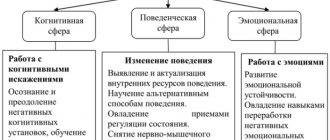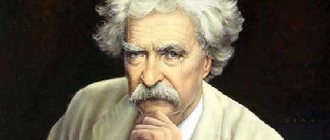Self-regulation is an important part of the human psyche, and it is useful for every person to master it. It's about managing your mental and emotional state, and this is undoubtedly a very useful quality. By influencing oneself with mental images, controlling breathing, or using other techniques, a person can “come to his senses” quite quickly. So how do you master self-regulation?
What is self-regulation
Mental self-regulation in psychology is the ability of an individual to analyze, evaluate, and then adjust both his own activity and its results. Essentially, this word means to put things in order. In this context, we can say that self-regulation of a person is a person’s conscious and organized influence on his own psyche, the main purpose of which is to change its properties and characteristics in the right direction.
Self-regulation of the body is based on patterns and their consequences, called psychological effects:
- motivating factors that encourage a person to act actively, while directing his efforts to change personal characteristics;
- the result of controlling voluntary or involuntary images arising in the subconscious;
- integrity and unity of cognitive processes that ensure the individual’s ability to influence his own psyche;
- the integrity of parts of consciousness and areas of the unconscious, with the help of which a person carries out self-regulation;
- functional connection between the emotional-volitional part of the personality and bodily experience, thinking.
Psychological self-regulation begins when an individual has a contradiction related to motivation. It can be safely called a driving force that encourages you to reconsider your inner world and some character traits.
Features of self-regulation by gender
Women are more susceptible to fear, irritation, anxiety, and fatigue than men. Men are more likely to experience loneliness, apathy and depression.
The methods of self-regulation used by men and women also differ. The men's arsenal of methods is much wider than the women's. The difference in self-regulation between the sexes is due to several factors:
- historically established differentiation of social roles;
- differences in the upbringing of girls and boys;
- specifics of work;
- cultural gender stereotypes.
But the biggest influence is the difference in the psychophysiology of men and women.
Women's methods of self-regulation are more of a social nature, while men's are biological. The direction of male self-regulation is internal (directed inward), while female self-regulation is external (directed externally).
In addition to gender, the characteristics of self-regulation are associated with age, mental and personal development of a person.
Self-regulation functions
The main task of self-regulation is to change mental activity so that a person can achieve internal harmony and balance. What does this give?
- The ability to restrain yourself from “exploding” in a conflict situation. A quarrel can be prevented before it even begins.
- In times of crisis or severe stress, a person can think adequately and make the right decisions.
- The individual can regain emotional strength.
And finally, the last function is confrontation with problems. Self-regulation allows you to achieve harmony with yourself and in relationships with others, which significantly improves your quality of life and helps you cope with any difficulties.
When is self-regulation needed?
A person experiences the need for self-regulation of mental states in several cases:
- with frequent irritability;
- with imbalance;
- if there is a feeling of emotional overstrain, bad mood;
- with depression, apathy, lack of joy and satisfaction from life;
- with decreased performance and endurance.
There are other factors whose presence prompts you to think about self-regulation. We are talking about a lack of self-confidence, low self-esteem, the inability or even inability to influence what is happening around, a lack of willpower and courage. Here you can add dissatisfaction from interaction with others, for example, failures in your personal life.
It is worth noting the fact that stressful situations are characterized by disturbances not only in the mental state, but also in physical health. Thus, a person’s general health deteriorates, causeless pain and sleep problems appear (most often insomnia). This also includes problems with excess weight. Remember how often in stressful situations we “eat up” negative emotions with something tasty, for example, another piece of cake or candy.
Self-regulation includes 3 main stages
Self-regulation contains 3 main stages:
- Mindfulness. The ability to be aware of your body.
- Concentration. Concentrate (have the skill of switching your attention from one process to another).
- Sixth Sense. Follow “healthy” spiritual impulses (intuition).
Having mastered these stages, self-regulation will increase your intellectual capabilities, strengthen psychological stability and enable you to quickly maneuver between emotions.
How does the nervous system recover? Fortunately, nature has endowed our nervous system with the ability to get rid of everything foreign. Stress, in the form of accumulated tension, is unnatural for the psyche.
Therefore, our nervous system always strives to get rid of it. True, to start the self-purification process, it needs to create certain conditions.
Kinds
There are the following types of human self-regulation:
- arbitrary;
- involuntary.
In the first case, a person clearly sees the goal and consciously controls his behavior to achieve it. This is how he develops individuality. In the second, the task of self-regulation is to survive and maintain health. It turns out that subconscious protection is triggered here.
In adulthood and old age, self-regulation is designed to maintain the connection between mind and emotions. But as the body ages, the balance shifts towards the latter.
Concept
Psychological self-regulation is an objective assessment of the situation, directed activity that allows you to control your own activity and correct the results of your actions.
There are two types of psychological self-defense:
- Involuntary - natural defense mechanisms that come from the subconscious. Focused on survival.
- Voluntary - conscious control of actions to achieve a set goal.
Self-regulation itself is formed throughout life, but self-awareness stops developing when a person stops learning responsibility and abandons self-development. Because of this, self-regulation suffers.
In adulthood, control over emotions is exercised by the intellect and is at its highest point. As we age, this balance shifts toward emotions. Because of this, psychologists compare old people with children.
Self-regulation depends on several factors:
- set goals;
- personality traits;
- environmental conditions;
- relationships between the subject and the surrounding world.
It is impossible to establish productive activities without a set goal; for this you need to additionally learn to control emotions.
Theories of self-regulation
In psychology, two theories of self-regulation are known.
System-activity
The author of this theory is L. G. Dikaya. According to her, self-regulation is an activity aimed at adaptation in a professional environment. It is also considered as a system for a person’s transition from unconscious forms of activity to conscious, almost automatic ones.
L. G. Dikaya conventionally identified several levels of mental self-regulation:
- Involuntary. It is based on excitation and inhibition, as well as activity uncharacteristic of the psyche. Such reactions fade away quickly and cannot be controlled.
- Arbitrary. Self-regulation is activated in critical situations. Here the intellect is united with emotions. All this manifests itself in increased motor activity, holding your breath, and a feeling of tension in the muscles.
- Conscious. A person not only realizes the presence of discomfort, but is also able to assess the severity of the condition. As a result, he decides to radically change the situation, using self-control, willpower, psychophysical exercises and auto-training.
The last and most interesting level is purposeful awareness. The individual understands that he can no longer tolerate what is happening in his life. Trying to get rid of unbearable discomfort, he reconsiders his values and priorities, and also analyzes his motives, desires and needs. There are two options for the development of events. In the first case, a person refuses activities that bring inconvenience and takes on his condition. In the second, the individual continues his activity, but at the same time includes self-regulation. Techniques such as self-hypnosis, introspection, and self-persuasion are used here.
In both cases, changes affect both behavior and the personality itself.
System-functional
The author of this theory of self-regulation is A. O. Prokhorov. In his opinion, self-regulation is nothing more than a change from one mental state to another. Moreover, the latter is connected with a person’s idea of the mood that he should have.
In order to obtain the desired reaction to conflict situations, an individual goes through several intermediate states. As a result, the reaction becomes conscious.
Prokhorov believed that the success of self-regulation directly depends on the level of awareness. It is also influenced by the accuracy of the presented image, the realism of feelings and emotions. The correctness of the achieved state is assessed based on bodily sensations, breathing, time, etc.
Approaches in psychology
In domestic psychology, the definition of emotional regulation is found in the following contexts:
- self-regulation of personality;
- regulation of behavior;
- mental self-regulation;
- self-regulation of states.
The mechanism of self-regulation and regulation of emotional states was considered by F.B. Berezin. In his works, the regulation of the body is associated with mental adaptation. Berezin argues that psychological defenses counter anxiety and stress. The research conducted led Berezin to the conclusion that there are individual personality characteristics that help to successfully adapt to stress. This is the level of neuropsychic stability, self-esteem, emotional response in conflicts and others.
The well-known approach of R.M. Granovskaya. She divides all methods of emotional regulation into three groups:
- Eliminating the problem.
- Reduce the intensity of a problem by changing your perspective.
- Relieve the impact of a negative situation using a number of methods.
Regulate the condition of R.M. Granovskaya suggests using weakening motivation. For example, you can reduce emotional tension when achieving a goal by concentrating not on the final result, but on tactics.
Components and levels of self-regulation
Self-regulation of emotional states is based on two mechanisms:
- Self-control. It first appears at about two years of age. It involves giving up something pleasant in order to achieve your goals.
- Agreement. Every person agrees that there is right and wrong behavior. At the age of 7, children can agree and refuse consciously.
A person who wants to master conscious self-regulation needs qualities such as: responsibility, flexibility, independence, perseverance, etc. You will also need will, the ability to find new motives and incentives to action. Based on this, the following levels of self-regulation can be distinguished:
- Operational and technical. This is a conscious activity that uses available means and resources.
- Motivational. This is a conscious direction of activity in the right direction by managing emotions and needs.
Self-regulation is not an automatic psychological defense mechanism. This is a conscious life choice. It is activated in situations where there is a need to change oneself, and not circumstances.
History of the discovery of the ability
The first scientist who made a great contribution to the discovery and further development of this skill was I.P. Pavlov. He learned to artificially influence the blood pressure of animals and change it using several methods:
- small cuts;
- introduction of various substances into the blood;
- nerve irritation.
He proved that after a change in blood pressure, it is enough to wait a little for it to recover. Thanks to this, the principle of self-regulation was developed. With the help of further research, the scientist found that this principle applies to all functions of the body.
The formation of self-regulation
As mentioned above, a person learns the basics of self-regulation in childhood. The process of its formation looks like this:
- From 3 to 4 years. In most cases, changes in the functional state occur involuntarily. Involuntary speech and motor methods of self-regulation alternate with voluntary or conscious ones in a ratio of 7-8 to 1.
- From 4 to 5 years. Children learn to manage their emotions through play. At this age the ratio looks like 4 to 1.
- From 5 to 6 years. The ratio of involuntary and voluntary self-regulation returns to normal (1 to 1). At this level, children have access to imagination, memory, thinking, and speech.
- 6-7 years. At this age, the child has access to such methods of self-regulation as self-control and self-correction. The ratio changes in the opposite direction. For every 1 involuntary method of psychological self-regulation there are 3-4 voluntary, conscious ones.
- The interval is 8-20 years. During this period, the teenager, and then the young man, improves the methods of self-regulation he uses, and also adopts something from those around him.
- Age from 20 to 40 years. The methods of changing the emotional state directly depend on what activity the individual is engaged in. Most often we are talking about the use of conscious methods.
- 40-60 years old. Attention manipulations are still effective. However, more and more often people are replacing them with something passive, for example, a quiet rest, a walk in nature or a trip to the library.
After 60 years, self-regulation is carried out only by passive methods. In most cases, this is communication, thinking alone, etc.
General principles
A number of mental states lead to disorganization, so they need to be regulated. There are two ways:
- Using external influence on the psyche.
- Self-hypnosis.
The concept of self-regulation relates to the second point, that is, a person helps himself to independently cope with a tense situation. Techniques of psychological self-regulation presuppose volitional participation; the person’s personality matters.
Mental self-regulation is the management of the emotional state by influencing oneself using words, images, muscle tone, and changes in breathing.
Psychological self-regulation allows you to eliminate emotional stress, reduce signs of fatigue, and increase psychophysiological reactivity.
Modern self-management of the condition is a kind of psychohygienic method that increases the body's resources.
Self-regulation techniques
First of all, it is worth saying that there are natural ways of self-regulation. These include:
- listening to classical music;
- walks in the fresh air, for example, in a nearby park;
- adequate rest and sleep;
- smiles, humor;
- reading your favorite books;
- drawing, embroidery;
- thinking about something good;
- singing, dancing;
- observing the beautiful landscape;
- pleasant memories, viewing photographs;
- sunbathing;
- communication with people who evoke exclusively positive emotions.
There are other methods and techniques of self-regulation:
- Relaxation. Everyone chooses their own way of relaxation. The main thing is that he achieves his goal: to achieve inner harmony, relieve muscle tension, regain control over feelings and emotions.
- Meditation. Helps you learn to concentrate, relax, relieve psycho-emotional stress and distract yourself from bad thoughts. Breathing techniques are most often used during meditation. The easiest option is to think about anything, just not about what annoys you.
- Desensitization. Involves conscious passivity, a clear idea of what successful behavior or activity looks like, and neutrality in relation to stimuli. All this is achieved through self-hypnosis.
- Autogenic training. Based on relaxation methods. They are exercises for relaxing muscles, developing the ability to accurately monitor the state of the body, and increasing volitional attitudes. The main task of this method of self-regulation is to relieve any tension and achieve absolute relaxation of the mind and body.
Don’t forget about visualization - creating a mental image of what you want, your goal. You need to imagine the end result and how you will go towards it.
Methods and techniques
People use different methods of self-regulation:
- meditation;
- relaxation;
- self-hypnosis;
- desensitization;
- autogenic training;
- reactive relaxation.
Relaxation
This technique can be voluntary or involuntary. When performing a free technique, the subject takes a relaxing pose and imagines a place in which he would be comfortable. Relaxation helps achieve several goals:
- restoring the body's energy;
- general health;
- relieving muscle tension;
- restoring mental balance.
The complex effect allows you to improve the general condition of the individual.
Desensitization
A technique used to get rid of anxiety and fear. There are several methods of desensitization:
- Relaxation. You need to calm down, scroll through disturbing situations in your thoughts. Repeated awareness allows you to get rid of fears and anxiety.
- Breath control. To regain freedom of action, you need to breathe calmly in a negative situation.
Another way is to eliminate fears with the help of pleasant impressions and new emotions.
Autogenic training
They were first proposed by a doctor from Germany, Schultz. Their principle is self-hypnosis. The techniques can be mastered through systematic exercises. The techniques are available to anyone. Thanks to training, you can cope with stress, strengthen strong-willed qualities, and normalize the emotional sphere.
Popular methods:
- To fill the capillaries with blood, you can think about heat, to relax the muscles - imagine lifting weights.
- Training to master the correct breathing technique. To do this, a person experiences a feeling of heaviness and warmth. They suggest to him that the heart rhythm is even. Once the subject is prepared, he should begin to repeat the phrase “I am calm.”
With the help of self-hypnosis, you can control your emotions and change your own state.
Meditation
The practice of meditation allows a person to relax, relieve emotional stress and fatigue. To carry it out, you need to allocate about 20 minutes every day. There are 2 types of meditation:
- relaxation;
- immersion in deep thought.
People who regularly practice meditation note its positive effects on the body.
In addition to the practices discussed, there are several methods of natural regulation:
- visiting literary evenings;
- listening to classical music;
- walks in the forest;
- intensive training, morning exercises;
- daily morning jogging;
- hardening;
- communication with charismatic people.
Some write down their experiences and negative emotions in a diary and analyze them. This helps to get rid of internal worries. It is important to use the techniques consciously.
Everyone has faced negative situations. A change in psychological state can lead to devastating consequences. To resolve conflict situations without a bad outcome, you need to learn self-regulation.
Self-regulation techniques and exercises
Psychologists have developed a lot of ways to relax and calm down, and normalize your psycho-emotional state. Everyone can choose the option for developing self-regulation that suits them.
Rocking
Take the most comfortable position for you, sitting or standing. Relax, tilt your head back. Close your eyes and gently swing to the sides, in a circle, or back and forth. Choose the pace and rhythm that is most comfortable for you.











